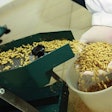On occasion, opportunity falls into your lap; other times you have to seek it out. Such is the case with the evolution of JBS United Inc.’s western Illinois grain division. From successfully adopting a continuous improvement program to seeking out a unique partnership with a local feed mill, this grain terminal has not stopped innovating.
In 1998, Sheridan, IN-based JBS United Inc., an international feed nutrient and grain marketing corporation, acquired a rail terminal in Griggsville, IL. In the beginning, the elevator was modest, operating one dump pit in the middle of an open field. At the time loading 50-car trains must have seemed like a pipe dream; however, being set in an ideal location — a fertile area chalked full of high-volume producers — with an empty canvas, set the stage for growth… and grow it did.
The terminal’s successful and dramatic expansion — and implementation of serious process improvements — can in part be attributed to the inspiration Tom Hurd, JBS United’s grain division’s chief operating officer, found in the management book Good to Great by Jim Collins.
As a result, this unit train loader facility on the Norfolk-Southern line has grown from a 4,000-bushel/hour to 70,000 bushel/hour handling operation in less than a decade.
The tools for success
“After reading the book, it became clear that once we had the right people on the bus, the sky was the limit for Griggsville,” Hurd says. Having hand selected a team of industry veterans, many having spent 20-plus years with other large grain elevators, it was time to take on the task at hand.
Hurd introduced the book’s “Hedgehog Concept” to the Griggsville team. The Hedgehog concept itself consists of a Venn diagram of three overlapping circles, each circle posing a different question: 1) what you are deeply passionate about, 2) what you can be the best in the world at, and 3) what best drives your economic engine.
“The Hedgehog concept provided a very simple way to communicate our mission and the goals of the organization to all employees,” Hurd says.
After taking an objective look at the facility and its potential, management evaluated the needs of the operation based on these three questions, and drew solutions from their collective experiences. After brainstorming, the group had created an outline of improvements and a strategy for implementing them.
“We really put ourselves in the farmer’s seat: What’s his experience when he drives in?” Hurd says. “Ultimately, we decided our goal was to be the fastest unloader in the area.”
A lofty goal indeed, but one JBS United felt could be achieved if the collective energy of the terminal’s employees was focused on providing this level of service to its customers.
Hurd explains how it works in practice: “Everybody on our team understands that everything we do is meant to increase our ability to unload — this goes for our capital expenditures, management decisions, grain accounting systems, operations at the scale — it becomes part of the decision making process of everything that we do.”
As operational changes are made, constant evaluation provides the checks-and-balances necessary to ensure the company is moving in the right direction.
“As we continue to upgrade and expand our facility, we go back and ask ourselves, ‘How will this fit into our hedgehog concept?’” says Randy Bleich, western Illinois region manager division. “Sometimes we’ve had to tweak things a bit so they do fit in with the concept.”
Admitting when you’re wrong and adjusting accordingly is a critical part of this process.
For example, recently the company changed accounting software providers. Unfortunately, after trying to work within the new system they realized they had “taken them back a few steps” — and the producers “let us know about that.” Acknowledging this pursuit had failed, JBS United’s grain division went back to the old system.
“In order to remain successful, we continue to fine tune our process,” Hurd says. “If we see something occurring that’s slowing things down we jump on it and correct it.”
Armed with this knowledge and a firm game plan, it was time to put it into action.
Becoming the fastest unloader
JBS first focused on streamlining truck management at the entryway.
“We wanted to allow producers to dump their grain and get back to the field as quickly as possible, Bleich explains. “We figured, ‘If we do this, they will come.’”
Since the bottlenecks always originated at the scale, the first step to increasing throughput was the addition of an outbound scale. JBS United merchandiser Dale Plumer explains, “Now that we have an inbound and outbound traffic line we have eliminated the dumping back log.”
Stop-and-go lights at the probe assist in controlling traffic flow. JBS United probes three to four trucks ahead of the scale, and by the time vehicles reach the scale, the grain has already been graded. After probing and grading, a digital sign then flashes a pit number instructing the truck to proceed to one of the terminal’s five dump pits —three high-volume 15,000 bushels/hour pits and two 12,000 bushels/hour pits.
The result: Trucks move through in less than five minutes. “Most elevators in the area are not able to turn a truck around that fast,” Bleich says. “For us, it’s just how we want to take care of the customer.”
The grain is then tracked internally from the probe to the bin. Under the guidance of Dave Crim, the operations manager for the three Illinois facilities, the parameters of each bushel is set and tracked by bin so JBS United can easily and accurately load rail cars to the customer’s specifications.
Today JBS United-Griggsville can process more than 500 trucks a day during harvest.
“Even in the gut slot of harvest, there is very little wait for farmers in comparison to other terminals during that time,” Hurd says. “That’s our advantage.”
Staying true to its “fastest unloader” mantra has given the Griggsville facility a corner on its market. In addition to Griggsville, the company operates three additional western Illinois locations: Pittsfield, New Canton, and the TMI feed mill elevator. JBS United’s market area spans 60 miles, covering all of Pike Country and reaching into Adams, Brown, Green and Calhoun County.
“In 2008, over 22 million bushel of corn was produced in Pike County; and JBS United handles over half of that in a year’s time,” says Plumer.
JBS United also operates a 100-car shuttle loader on the Union Pacific railroad eastern Illinois grain region called the Busboom region, located in Royal, Collison and Rossville.
Maximizing throughput capacity
Having the luxury of excess land to expand its operations was one of the facility’s key advantages in its quest to improve efficiency.
“Over the last 10 to 15 years, the footprint has evolved,” Bleich says. “We’re lucky there was plenty of land for expansion; because of space constraints, many elevators don’t have this opportunity.”
Over the course of four years, the main additions aiding in the growth of the Griggsville terminal included: adding two dump pits; extra storage capacity; the addition of an outbound scale; and placing the probes far ahead of the inbound scale.
The Griggsville facility has 6.6 million bushels of upright storage with an additional 2.3 million bushels of storage capacity available in its temporary storage bunkers; it handles and stores corn (65%), soybeans (30%) and wheat (5%).
Equipment upgrades are an integral part of sustaining success. Recent investments include a 1 million bushel temporary storage bunker that is filled with an overhead coveyor in 2008; and then expanded it an additional 700,000 bushels last year, bringing JBS United-Griggsville’s temporary storage capacity to 2.3 million.
This summer JBS United-Griggsville plans to install a new Zimmerman dryer. While its current dryer handles 5,000 bushels/hour, the new dryer will allow for an added 7,000 bushels/hour drying capacity. Hurd says: “Soon we’ll be bringing our drying capacity to over 12,000 bushel/hour so we should be able to effectively handle whatever the next harvest brings.”
A mutually beneficial partnership
In addition to the internal adoption of the Hedgehog Concept, JBS United has sought out external productivity-enhancing opportunities.
In 2005, JBS United customer The Maschhoffs, one of the largest family-owned pork production networks in the United States, purchased an old Tate and Lyle feedmill in Pittsfield, IL. When The Maschoffs outgrew the Pittsfield plant; the company decided to build a new feedmill and grain receiving facility near Griggsville.
“Since [JBS United] has always been the only supplier originating corn for [The Maschoffs], we decided we wanted to explore all the possibilities for a joint partnership when we found out they were going to build a new feedmill and elevator,” Bleich says. “Since we had a good working relationship in last six years, we thought there may be good possibilities to do the origination for the new feedmill.”
In 2009 The Maschoffs’ opened its 1.6 million bushel grain receiving facility. Unique to their business model, JBS United leases The Maschoffs’ new grain elevator and originates the grain coming into it – but The Maschoffs’ employees operate the facility. Under the grain origination contract, JBS United is the sole supplier of grain to The Maschoffs’ Griggsville facility.
“The producer delivers directly to them as if it were another JBS United operation; we pay the farmer, and then The Maschoffs’ purchase it from us,” Hurd says. “This is a unique method of operation because all the grain that comes through [The Maschoffs] is purchased by [JBS United] — but we do not run the elevator.”
Brett Roe, associate director of ingredient purchasing and feed order management with The Maschoffs, explains: “We simply communicate our needs with [JBS United] and buy x-amount of bushels a week and they designate The Maschoff’s as a destination point to the producers,”
Once The Maschoffs’ feedmill is up and running in June, the grain JBS United procures will be used in the new mill. (See sidebar on page XX to read about The Maschoffs new feedmill.)
Hurd describes the partnership as creating a “three-way benefit” between the area producers, The Maschoffs and JBS United.
“The way it’s set up is good for everybody,” Hurd says. “Forming a partnership with a major end-user in the area has created synergy between [JBS United] divisions.”
Meanwhile, JBS United and The Maschoffs benefit because they are not competing against each other for grain, affecting the profits of both companies and increasing volume at a lower cost.
“To the producer, they can deliver to [The Maschoffs] facility or any of the other three JBS United facilities in that area,” he explains. “Whether they chooses to put their grain into storage for delayed pricing, or to put it into a merchandising program — it doesn’t make a difference where they deliver it, they will receive a check from us. It’s a one-stop shop.”
Local producers also cut their transportation costs because there is now another outlet to consume an extra 3 million bushels of corn in the area.
“The benefit we brought to the table is another destination location for JBS United,” Roe says. “Your infrastructure is only going to support so much, and we made the investment in infrastructure to allow them to merchandise more corn without making an investment in bins, pits or people. It’s an opportunity for them to have access to another dryer with a wet harvest this is a tremendous benefit to have access to another dryer.”
The consensus: It’s been a win-win for everyone involved. “Made sense from both sides, another location for them – worked out well for both parties,” Roe says.
Last fall was a successful “dry run” for The Maschoffs as it filled its elevator for the first time.
Plumer explains: “The wet corn last year did produce a backlog, and we were working to catch up with the drying. It was a great help to us because we were able to use [The Maschoffs] 5,000 bushel/hour GSI dryer – helping to double our drying capacity.”
Regardless of the investments a company can make, the true success of any operation lies in the employees. JBS United-Griggsville has seven full-time employees; and rotates four to 10 temporary employees during harvest time.
“The strength of any operation is in the people,” Hurd says. “You can have the dumping capacity, as we have at Griggsville, but if the rest of the operation isn’t fine tuned, a backup can occur. We continue to fine tune storage, wet holding, scale and probe times. It all comes down to your people and they just do a tremendous job”


















